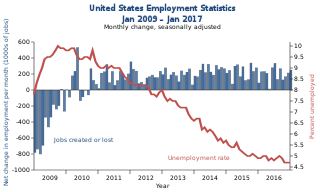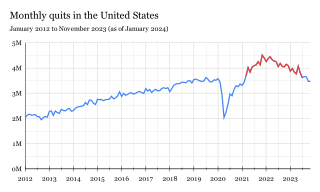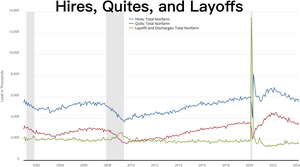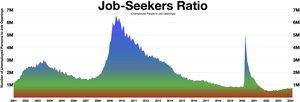
Unemployment, according to the OECD, is people above a specified age not being in paid employment or self-employment but currently available for work during the reference period.

The Bureau of Labor Statistics (BLS) is a unit of the United States Department of Labor. It is the principal fact-finding agency for the U.S. government in the broad field of labor economics and statistics and serves as a principal agency of the U.S. Federal Statistical System. The BLS collects, processes, analyzes, and disseminates essential statistical data to the American public, the U.S. Congress, other Federal agencies, State and local governments, business, and labor representatives. The BLS also serves as a statistical resource to the United States Department of Labor, and conducts research measuring the income levels families need to maintain a satisfactory quality of life.
An economic indicator is a statistic about an economic activity. Economic indicators allow analysis of economic performance and predictions of future performance. One application of economic indicators is the study of business cycles. Economic indicators include various indices, earnings reports, and economic summaries: for example, the unemployment rate, quits rate, housing starts, consumer price index, Inverted yield curve, consumer leverage ratio, industrial production, bankruptcies, gross domestic product, broadband internet penetration, retail sales, price index, and changes in credit conditions.

In economics, a discouraged worker is a person of legal employment age who is not actively seeking employment or who has not found employment after long-term unemployment, but who would prefer to be working. This is usually because an individual has given up looking, hence the term "discouraged".

The labor force is the actual number of people available for work and is the sum of the employed and the unemployed. The U.S. labor force reached a high of 164.6 million persons in February 2020, just at the start of the COVID-19 pandemic in the United States. Before the pandemic, the U.S. labor force had risen each year since 1960 with the exception of the period following the Great Recession, when it remained below 2008 levels from 2009 to 2011. In 2021, The Great Resignation resulted in record numbers in voluntary turn over for American workers.
A layoff or downsizing is the temporary suspension or permanent termination of employment of an employee or, more commonly, a group of employees for business reasons, such as personnel management or downsizing an organization. Originally, layoff referred exclusively to a temporary interruption in work, or employment but this has evolved to a permanent elimination of a position in both British and US English, requiring the addition of "temporary" to specify the original meaning of the word. A layoff is not to be confused with wrongful termination. Laid off workers or displaced workers are workers who have lost or left their jobs because their employer has closed or moved, there was insufficient work for them to do, or their position or shift was abolished. Downsizing in a company is defined to involve the reduction of employees in a workforce. Downsizing in companies became a popular practice in the 1980s and early 1990s as it was seen as a way to deliver better shareholder value as it helps to reduce the costs of employers. Research on downsizing in the US, UK, and Japan suggests that downsizing is being regarded by management as one of the preferred routes to help declining organizations, cutting unnecessary costs, and improve organizational performance. Usually a layoff occurs as a cost-cutting measure. A study of 391 downsizing announcements of the S&P 100 firms for the period 1990-2006 found, that layoff announcements resulted in substantial increase in the companies’ stock prices, and that the gain was larger, when the company had prior layoffs. The authors suggested, that the stock price manipulation alone creates a sufficient motivation for publicly-traded corporations to adopt the practice of regular layoffs.

Termination of employment or separation of employment is an employee's departure from a job and the end of an employee's duration with an employer. Termination may be voluntary on the employee's part (resignation), or it may be at the hands of the employer, often in the form of dismissal (firing) or a layoff. Dismissal or firing is usually thought to be the employee's fault, whereas a layoff is generally done for business reasons outside the employee's performance.

Nonfarm payroll employment is a compiled name for goods, construction and manufacturing companies in the US. Approximately 80% of the workforce is accounted for nonfarm payrolls and it excludes farm workers, private household employees, actively serving military or non-profit organization employees. Approximately 131,000 businesses and government agencies, which amounts to around 670,000 worksites, are surveyed on a monthly basis.

The Conference Board, Inc. is a 501(c)(3) non-profit business membership and research group organization. It counts over 1,000 public and private corporations and other organizations as members, encompassing 60 countries. The Conference Board convenes conferences and peer-learning groups, conducts economic and business management research, and publishes several widely tracked economic indicators.
In human resources, turnover is the act of replacing an employee with a new employee. Partings between organizations and employees may consist of termination, retirement, death, interagency transfers, and resignations. An organization’s turnover is measured as a percentage rate, which is referred to as its turnover rate. Turnover rate is the percentage of employees in a workforce that leave during a certain period of time. Organizations and industries as a whole measure their turnover rate during a fiscal or calendar year.

The Society for Human Resource Management (SHRM) is a professional human resources membership association headquartered in Alexandria, Virginia. SHRM promotes the role of HR as a profession and provides education, certification, and networking to its members, while lobbying Congress on issues pertinent to labor management.
Challenger, Gray & Christmas is headquartered in Chicago, Illinois, and is the first executive outplacement firm in the US. It has offices throughout North America. James E. Challenger is the founder of the company. The Society for Human Resource Management recognized him in 1996 as the creator and pioneer of the outplacement field. James E. Challenger, the company's founder, spent years trying to persuade companies that it was good business to be nice to people heading involuntarily out the door.
Employee offboarding describes the separation process when an employee leaves a company. The offboarding process might involve a phased transfer of knowledge from the departing employee to a new or existing employee; an exit interview; return of any company property; and various processes from the company's human resources, information technology, or legal functions.

Unemployment in the United States discusses the causes and measures of U.S. unemployment and strategies for reducing it. Job creation and unemployment are affected by factors such as economic conditions, global competition, education, automation, and demographics. These factors can affect the number of workers, the duration of unemployment, and wage levels.
Job losses caused by the Great Recession refers to jobs that have been lost worldwide within people since the start of the Great Recession. In the US, job losses have been going on since December 2007, and it accelerated drastically starting in September 2008 following the bankruptcy of Lehman Brothers. By February 2010, the American economy was reported to be more shaky than the economy of Canada. Many service industries have reported dropping their prices in order to maximize profit margins. This is an era in which employment is becoming unstable, and in which being either underemployed or unemployed is a common part of life for many people.
Statistics on unemployment in India had traditionally been collected, compiled and disseminated once every ten years by the Ministry of Labour and Employment (MLE), primarily from sample studies conducted by the National Sample Survey Office. Other than these 5-year sample studies, India has – except since 2017 – never routinely collected monthly, quarterly or yearly nationwide employment and unemployment statistics. In 2016, the Centre for Monitoring Indian Economy, a non-governmental entity based in Mumbai, started sampling and publishing monthly unemployment in India statistics.

The Great Resignation, also known as the Big Quit and the Great Reshuffle, was a mainly American economic trend in which employees voluntarily resigned from their jobs en masse, beginning in early 2021 in the wake of the COVID-19 pandemic. Among the most cited reasons for resigning included wage stagnation amid rising cost of living, limited opportunities for career advancement, hostile work environments, lack of benefits, inflexible remote-work policies, and long-lasting job dissatisfaction. Most likely to quit were workers in hospitality, healthcare, and education.












